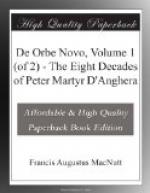[Note 8: Possibly the simia seniculus.]
Leaving Cariai and sailing a distance of twenty leagues the Spaniards discovered a gulf of such size that they thought that it must have a circumference of twelve leagues. Four small fertile islands, separated from one another by narrow straits, lie across the opening of this gulf, making it a safe harbour.
We have elsewhere called the port, situated at the extreme point, by its native name of Cerabaroa; but it is only the right coast upon entering the gulf bears that name, the left coast being called Aburema. Numerous and fertile islands dot the gulf, and the bottom affords excellent anchorage. The clearness of the water makes it easily discernible, and fish are very abundant. The country round about is equal in fertility to the very best. The Spaniards captured two natives who wore gold necklaces, which they called guanines. These collars are delicately wrought in the form of eagles, lions, or other similar animals, but it was observed that the metal was not very pure. The two natives, brought from Cariai, explained that both the regions of Cerabaroa and Aburema were rich in gold, and that all the gold their countrymen required for ornaments was obtained from thence by trading. They added that, in six villages of Cerabaroa, situated a short distance in the interior of the country, gold was found; for from the earliest times they had traded with those tribes. The names of those five villages are Chirara, Puren, Chitaza, Jurech, and Atamea.
All the men of the province of Cerabaroa go entirely naked, but they paint their bodies in different ways, and they love to wear garlands of flowers on their heads, and bands made from the claws of lions and tigers. The women wear narrow waist-cloths of cotton.
Leaving this harbour and following along the same coast, a distance of eighteen leagues, the Spaniards came upon a band of three hundred naked men, upon the bank of the river they had just discovered. These men uttered threatening shouts and, filling their mouths with water and the herbs of the coast, spat at them. Throwing their javelins, brandishing their lances and machanes, which we have already said




